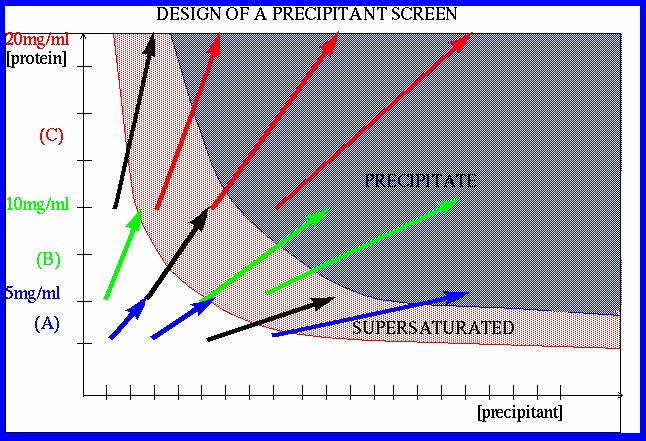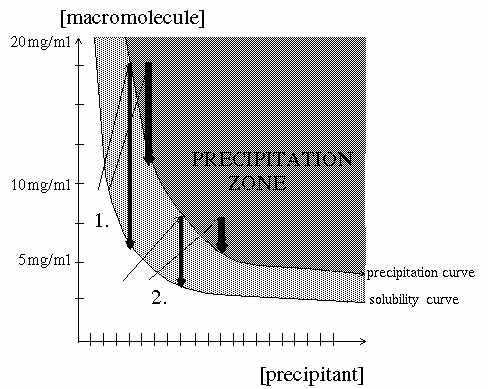The Footprint screening Technique:

We give the term "footprint" to a screen which maps out the solubility characteristics of a macromolecule. Footprint experiments carried out in our laboratory consists typically of four different precipitant concentrations and two or more protein concentrations to map out a wide range of the precipitant/protein concentration plot as shown graphically above. A footprint type screen is generally carried out using vapour diffusion experiments. Vapour diffusion has the ability to concentrate the protein and the precipitant relatively slowly by two fold, or a different increase depending on the relative size of the protein and precipitant drops mixed. When analysing the results of each footprint, the morphology of various precipitates and the separation of the protein into phases is taken into account and correlated with biochemical analysis. The various precipitates may arise from heterogeneous components of the protein solution, each of which may have a separate precipitation point. The use of a standardized footprint type screen has certain advantages in comparing solubility changes between macromolecules and their complexes, different preparations and purification schemes. Footprint type screens should be designed from previous experience or from the BMCD crystallization database or to conform to specific requirements of individual macromolecules. It is useful to map out footprint solubility results roughly as shown below to help in the design of a subsequent fine search with a chosen precipitant(s) in order to refine precipitation conditions, and to test for additives. If needed, other precipitants are selected and the process restarted.

The protocol for proteins, or for their complexes, that have previously been crystallized is not substantially different. A footprint screen is still set up to compare solubility of the current protein sample or the new complex to that previously obtained or expected from published work. Refinement, additive evaluation, and seeding follows.
In summary, information about solubility from the initial preparation and purification steps, from prior crystallization experiments of homologous macromolecules, from the effect of ligands on biological activity are used in the design of an initial screen. One or more precipitants are selected for refinement of conditions based on the solubility characteristics of the individual macromolecule being crystallized. The effectiveness of additives is then evaluated close to the precipitation boundary. A different complex or a different precipitant is selected if crystals are not obtained at this stage after refinement and additive evaluation.
Updated/Created on Sep-23-97 by EAS,
TSRI


